The 9 muscles of the arm (classified and explained)
What we commonly call the arm is actually the entire upper limb, made up of the arm and forearm being anatomically precise.
The muscles of the arms and forearms allow us to do everyday actions such as writing, picking up an object, pointing, bearing a weight and many more. Our upper extremities are capable of many movements without which human life would be very different.
Here we will see how they are the muscles of the arm and forearm, all of them involved in the manual tasks of our day to day, and then we are going to discover them.
- Related article: "Muscle fiber: what is it, parts and functions"
The muscles of the arm and forearm
The muscles of the arm and forearm can be classified according to different criteria. In this article we are going to explain the muscles of the upper limb according to their position but, also, it is usual find them differentiated according to whether they are short or long, which allows the muscles to have one or the other movement.
But before going into detail about what the arm muscles are, we must first understand that what we commonly call the arm is not anatomically correct.
The arm in its popular sense corresponds to the human upper limb in the anatomical sense, because terminologically speaking correctly the arm is only part of our upper extremities. So we can say that the human upper extremities can be divided into two:- Arm: region that extends from the clavicle to the elbow.
- Forearm: region that extends from the elbow to the wrist.
Within these two anatomical regions we can in turn differentiate two other parts:
Anterior aspect of the arm and forearm
The anterior face of the arm and forearm is the one that is on the palm side of the hand. To see the front of your upper extremities, you just need to put your arms close to the trunk, with the palms of the hands facing up. By doing this simple exercise you will be looking at the front of your arms and forearms.
- Related article: "Muscular system: what is it, parts and functions"
Posterior aspect of the arm and forearm
The back of the arm and forearm is the part that is on the side of the back of the hand. To see the back of your limbs, simply place your arms as before, only with your palms facing downward.
- You may be interested in: "The 12 benefits of weight training"
Types of arm muscles
In the arm itself we can find two groups of muscles: the muscles of the anterior face and the muscles of the posterior face.. The muscles of the anterior face are in charge of the flexion movements, while those of the posterior face are in charge of the contraction (contractor muscles). These muscle groups are called antagonistic or antagonistic to each other because, when an anterior muscle flexes, the posterior muscle contracts.
1. Anterior muscles of the arm
The main anterior muscles of the arm are as follows.
1. 1. Brachial biceps
The biceps brachii is a muscle that runs from the clavicle to the elbow, in the intertubercular groove of the humerus. Its main functions are the rotation of the forearm and the flexion of the forearm over the elbow. The biceps brachii is a very bulky muscle that, when contracted, can be easily seen. It consists of two parts or "heads" (that's why it's called the biceps): the short head of the biceps and the long head of the bicep.
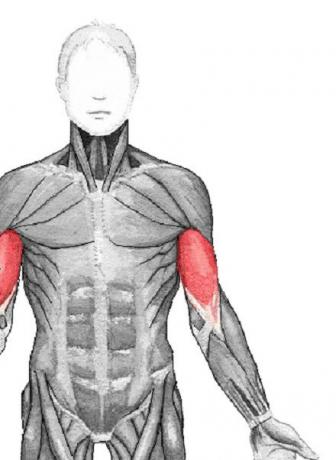
1.2. Brachial
This muscle is deeper than the biceps brachii and is smaller. Its shape is wide and flattened. The brachialis is the main flexor muscle of the forearm on the arm.
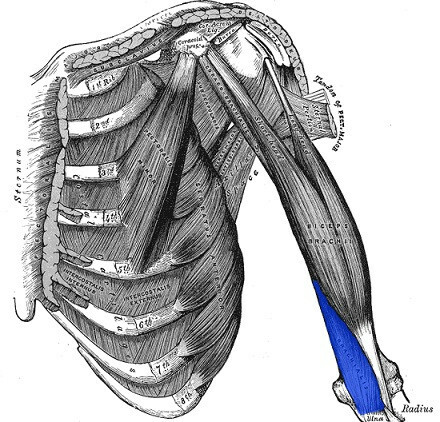
1.3. Coracobrachial
The coracobrachialis is a thick, prismatic muscle that occupies the space from the scapula to the biceps passing through the short portion of the biceps brachii. This muscle specializes more in quick movements than generating force, something that the biceps takes care of, much more voluminous. The main function of the coracobrachialis is to raise the arm by keeping the shoulder low, balancing the movement of the arm, and restoring the anatomical position.
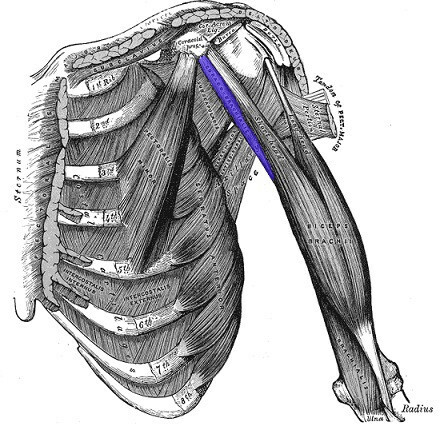
- Related article: "Bone system: what is it, parts and characteristics"
2. Posterior arm muscles
As for the back muscles of the arm, the two main ones are the following:
2.1. Triceps brachii
This muscle occupies most of the posterior region of the arm.. As its name suggests, the triceps is made up of three parts or "heads": long head and vast internal and external. The main function of this movement is antagonistic to that of the biceps, in this case being responsible for the extension of the forearm over the elbow.
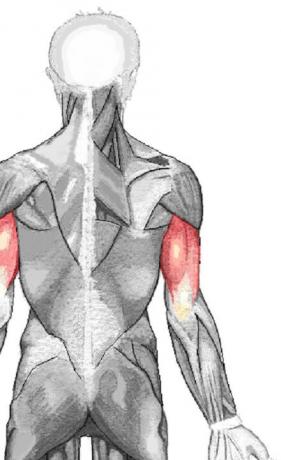
2.2. Anconeus muscle
The anconeus muscle is small and triangular in shape, and contacts by its proximal extremity with the triceps and elbow. Cooperate with the triceps brachii during the extension of the forearm over the elbow.
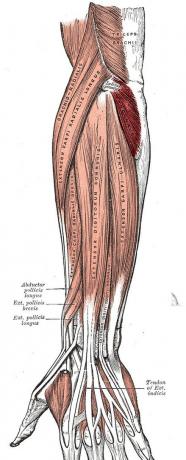
- You may be interested in: "Daniels scale: what it is, characteristics, and functions"
3. Forearm muscles
The muscles found in the forearm can be classified into the following three groups.
- Finger flexors: on the front of the forearm.
- Finger extensors: on the back of the forearm.
- Supinators or external rotators of the forearm: on the radial border, towards the thumb.
3.1. Muscles of the anterior part of the forearm
The list of muscles of the forearm is the following.
- Pronator teres muscle
- Pronator quadratus muscle
- Flexor carpi radialis muscle
- Palmar longus muscle
- Flexor carpi ulnar muscle
- Flexor superficialis muscle of the fingers
- Deep flexor muscle of the fingers
- Flexor pollicis longus muscle
Among them we can highlight the following.
3.1.1. Deep flexor muscle of the fingers
The deep flexor muscle of the fingers, together with the superficial common flexor of the fingers of the hand, it allows to flex the fingersexcept the thumb. This muscle is associated with a long tendon that runs down the forearm and crosses the carpal tunnel to insert on the palmar side of the phalanges of the fingers.
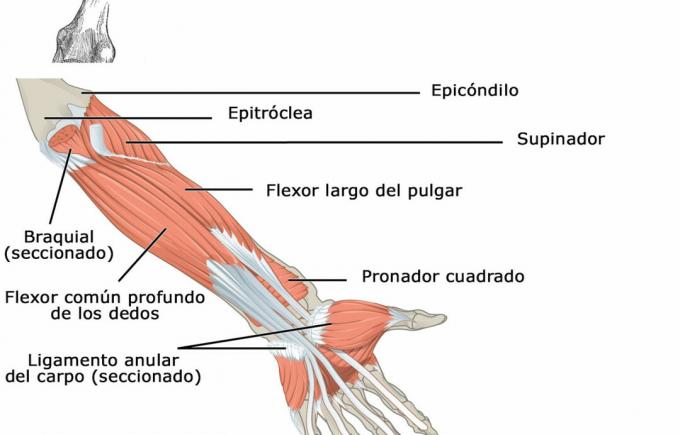
3.1.2. Flexor superficialis muscle of the fingers
The superficial flexor muscle of the fingers, together with the anterior, allows flexing the fingers, specifically the flexion of the middle phalanx on the proximal phalanx and the hand on the forearm.
3.2. Muscles of the back of the forearm
The list of muscles in the back of the forearm is as follows:
- Extensor digitorum muscle
- Extensor carpi ulnaris muscle or posterior ulnar muscle
- Abductor pollicis longus muscle
- Extensor pollicis brevis muscle
- Extensor pollicis longus muscle
- Extensor index muscle
- Short palmar muscle or cutaneous palmar muscle
Of all these muscles the most notable is the extensor digitorum muscle.
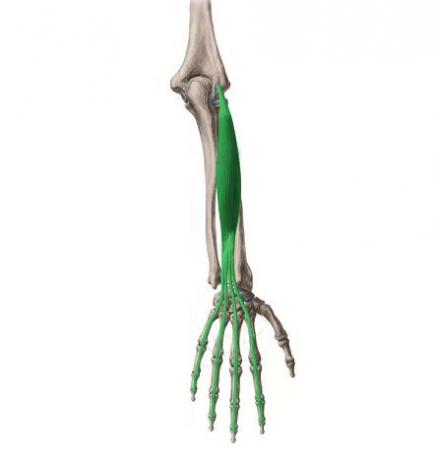
The extensor digitorum muscle runs throughout the forearm, going from the elbow to the dorsal part of the wrist where it is associated with four tendons, passing through them to the fingers two (index), three (middle or middle), four (ring) and five (little finger) of the hand, all except the thumb. This muscle is responsible for the extension of the wrist and the proximal phalanx of the fingers, although it is also slightly involved in the extension of the arm.
3.3. Lateral forearm muscles
Finally, it is time to talk about the lateral muscles of the forearm. Among them we find:
- Short supinator muscle
- First radial or long radial
- Second radial or short radial
- Long supinator muscle
The most notable muscle in this region is the long supinator muscle..
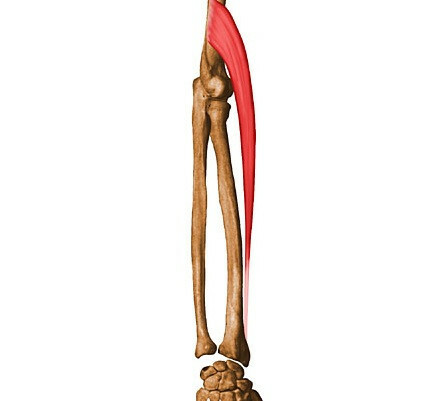
This is located on the upper outer part of the forearm, near the elbow. This muscle helps to rotate the forearm both externally and internally. Depending on the disposition of the elbow, different movements can be made, which gives a great variety of movements to the forearm.
